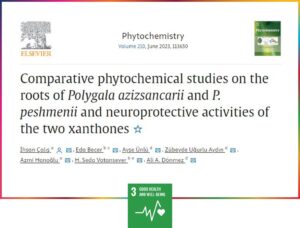
Researchers Çalış, Becer, Hanoğlu and Vatansever from Near East University have contributed as co-authors to a study revealing significant findings regarding the therapeutic potential of compounds isolated from the roots of Polygala peshmenii Eren, Parolly, Raus & Kürschner and Polygala azizsancarii Dönmez, both narrow endemic species in Türkiye. The study focused on identifying and characterizing several compounds, including sucrose esters and xanthones, through rigorous spectroscopic analyses. Notably, the isolation of an unprecedented xanthone compound from natural sources underscores the novelty of the findings.
In vitro experiments using SKNAS human neuroblastoma cells as an Alzheimer’s disease (AD) model demonstrated promising neuroprotective effects of two xanthones, specifically 1,3,6-trihydroxy-2,5,7-trimethoxyxanthone and 3-O-β-D-glucopyranosyloxy-1,6-dihydroxy-2,5,7-trimethoxyxanthone, isolated from P. azizsancarii roots. These compounds exhibited the ability to modulate tau aggregation without affecting pre-existing β-amyloid plaques, shedding light on their potential in mitigating AD-related neuropathology.
Immunohistochemical staining revealed favorable alterations in the distribution of key proteins associated with AD pathology, including tau, JAK/STAT3, and BMP-2, upon treatment with the identified xanthones. Remarkably, a significant reduction in caspase 3 immunoreactivity was observed, indicative of a potential mechanism for the compounds’ ability to rescue neuronal cell death in AD.
Furthermore, while P. peshmenii root extract showcased richness in xanthone-type metabolites, both P. azizsancarii and P. peshmenii extracts shared common compounds such as sucrose esters and saponins. This reinforces the understanding that the Polygalaceae family harbors a diverse array of bioactive compounds, with xanthones being particularly notable for their pharmacological potential.
In summary, this collaborative study underscores the therapeutic promise of natural compounds derived from Polygala species in combating neurodegenerative diseases like AD. By elucidating their mechanisms of action and highlighting their distinct chemical profiles, these findings contribute valuable insights towards the development of novel therapeutic strategies for AD and related disorders.
More Information:
https://www.sciencedirect.com/science/article/pii/S0031942223000663